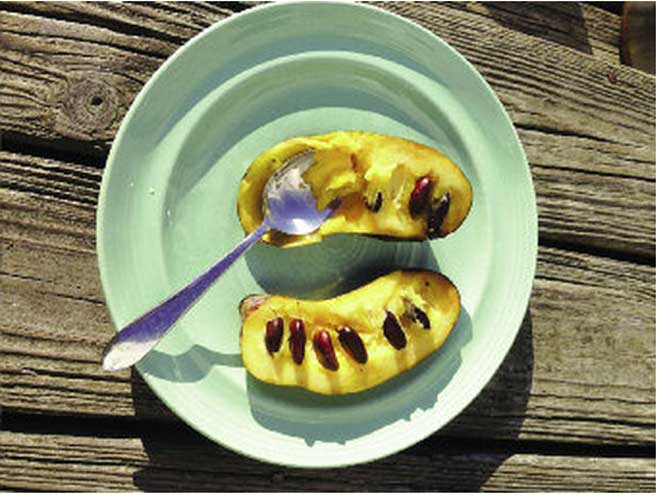Farm Girl Confidential: Pawpaw, Tropical Fruit on Cape Cod?
The 2014 growing season was fabulous! Off to a late start, but once it got going you couldn’t have asked for more: sunny, rain showers every few days and moderate temperatures (and a hail storm for some). It was perfect. So much so that for only the second time in twelve years my peach tree showered us with peaches. They were falling from the tree and rolling into the sheep pen for weeks, and I had to beat not only the sheep, but the raccoons in order to gather them.
We had so many peaches for such a long time that I had to get creative. Fresh is best, so for breakfast, we diced them into every bowl of cereal, snacked them off the tree during the day and then made cobblers at night and eventually started canning them for jam. The cobbler was our favorite, hot out of the oven, made with cinnamon and nutmeg and topped with vanilla ice cream. We took advantage of every moment, knowing that our peach tree might not fruit again for years. I actually canceled a previously planned trip just to catch the peaches as they fell.
We were so sad to see the crop dwindle in mid-September, but then to my surprise, as autumn arrived and leaves were falling from the trees, a new fruit, a seemingly tropical fruit, appeared in our yard in mid-October!
I was raking up the sheep pen when I tripped over something that looked like a giant green peanut. I picked it up and couldn’t believe what it was. Twelve years ago, the same year that I had planted the peach tree, I ordered an unusual tree called a Northern pawpaw (Asimina triloba). The pawpaw is the only temperate member of the tropical Annonaceae family and is the largest tree fruit native to the United States. It is the northernmost New World representative of a chiefly tropical family, which also includes the tropical fruits custard apple, sugar-apple, and soursop. Unusual in appearance, it looks like a mango but actually tastes like a banana with a hint of pineapple. Surprisingly it is native to most of the eastern U.S. and even into Canada, although I don’t know of anyone around here who has seen one before.
The pawpaw grows best in areas with hot summers and cold winters (zones 5-8) and thrives in rich, moist, slightly acid soils. Sandy soil, sandy loam, medium loam, clay loam and clay soils are all tolerated by the pawpaw tree, and as for liking moist soil, it certainly never had it here. It is a good understory tree with no serious disease or insect problems. Its flowers emerge before leaves in mid-spring and the blossoms occur singly on the previous year’s wood. It does require another tree for good fruit set, but as I discovered, it will eventually send out root suckers like the sassafras or sumac tree does, creating its own thicket or colony of trees. Pollination is believed to be by flies and beetles, which is consistent with the appearance of its odd flower: dark, meat-colored petals and a fetid aroma, which may be one of the reasons that fruit set is so inconsistent since its not visited by bees. The old recommendation to hang road kill in your trees to attract fly pollinators may help, but I don’t think I’d advise it.
Studies on the nutrient value of the pawpaw indicate a very high antioxidant count, about equal to the cranberry. Its leaves, bark and twigs are a source of phytochemicals called acetogenins, with powerful anti-carcinogenic properties that are being used in the development of anti-cancer drugs and botanical pesticides. An herbal extract made from pawpaw is currently on the market. It is also claimed that its pesticide properties are better than those of the highly acclaimed and widely used spinosad.
My pawpaw trees are growing in the sheep pasture and it is no wonder that the sheep have left the trees alone (they usually strip the bark and eat all the leaves on any tree in their path). Even the new, young suckers are untouched, which prompts me to wonder if perhaps naturalizing them in fruit orchards might help reduce insect damage in organic applications. Or could it be a good choice for deer-resistant landscape plantings?
Pawpaw trees have great potential for the commercial market in many venues. One basic reason is its genetic variability that can be used to improve the plant for its many possible uses. They make a great edible landscape tree, tolerating shade with great, exotic leaves and giving a nice show of fall color in bright yellow. The high level of natural defense compounds in the tree make it highly resistant to insect and disease infestation, thereby yielding a care-free fruit tree for both the homeowner and for commercial applications. They are also perfect for butterfly gardens as they attract the zebra swallowtail, for which they are the exclusive larval host plant. Pawpaw is well adapted to the 25 states to which it is native and where it already grows in the wild. It requires a minimum of 400 hours annual chill and 160 frost-free days. Easily grown from seed, it does need stratification for successful germination. (Seed Stratification is the manipulation of climatic conditions—mimicking Mother Nature—of seed before germination, usually accomplished by storing seed in a freezer. Asimina triloba seed must be kept moist to retain viability. Seed dormancy and embryo immaturity require a cool-moist (32 to 41 degrees) storage period for 90 to 120 days. Subjecting the seed after stratification to warm (75-85 degrees) temperatures initiates germination.)
Pawpaw is also a source of excellent nutrition. Eaten fresh when fully ripe it exceeds apple, peach and grape in most vitamins, minerals, amino acids and food energy value. The flesh purees easily and freezes nicely. Pawpaw can substitute in equal part for banana in most recipes. Although their unrefrigerated storage is very limited—lasting only a day or two—they are good in cold storage for about two weeks and that’s pretty good for any fruit!
When I served the fruit, picked green-skinned with a slight give to the flesh, it was welcomed with cautious enthusiasm. No one was quite convinced that an exotic fruit grown right here on Cape Cod could possibly compare to a tropical fruit. That was until they tasted it. It does taste like both pineapple and banana, releasing subtle undertones of each flavor, the pineapple initially and a banana aftertaste. Everyone agreed that a squeeze of lime on top would be perfection.
So I can definitely recommend the pawpaw tree to any enthusiast of rare and exotic plants. I bought mine from Stark Bro’s (starkbros.com), but they can be purchased through many commercial nurseries.





